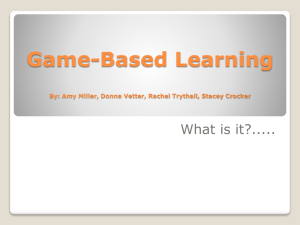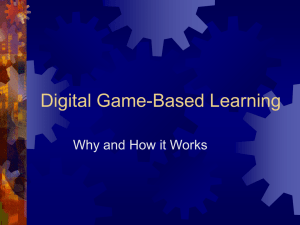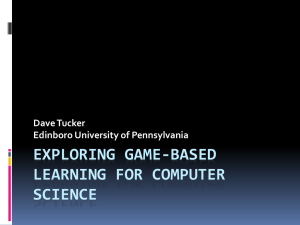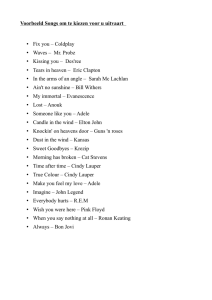Game-based E-Learning Applications by applying the E
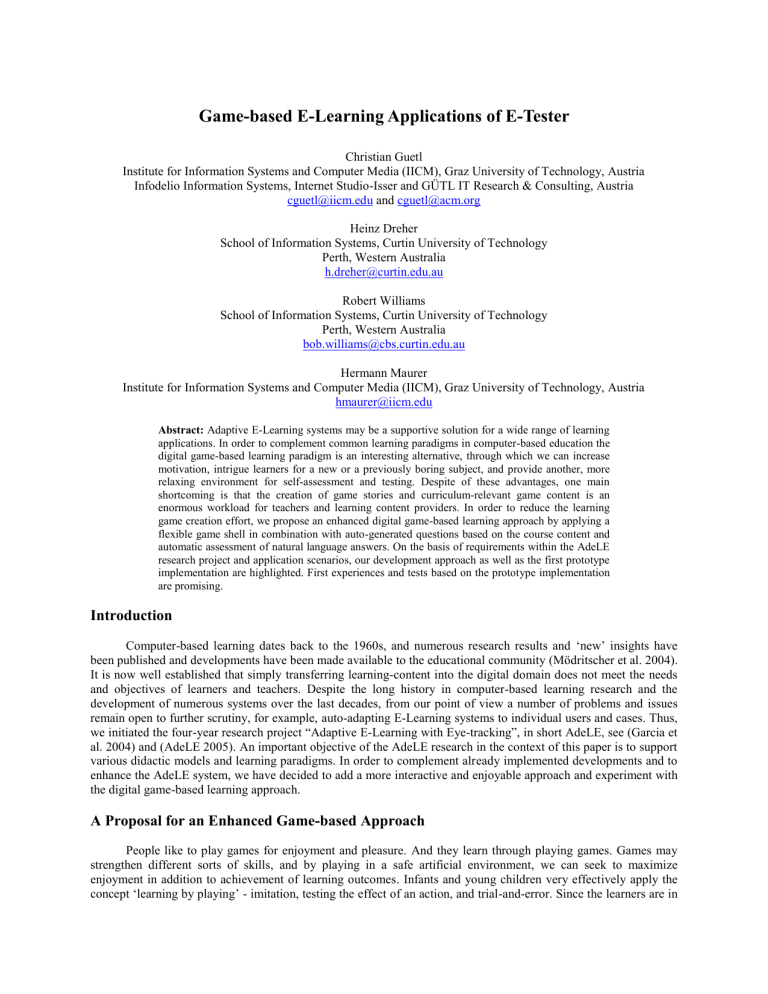
Game-based E-Learning Applications of E-Tester
Christian Guetl
Institute for Information Systems and Computer Media (IICM), Graz University of Technology, Austria
Infodelio Information Systems, Internet Studio-Isser and GÜTL IT Research & Consulting, Austria cguetl@iicm.edu
and cguetl@acm.org
Heinz Dreher
School of Information Systems, Curtin University of Technology
Perth, Western Australia h.dreher@curtin.edu.au
Robert Williams
School of Information Systems, Curtin University of Technology
Perth, Western Australia bob.williams@cbs.curtin.edu.au
Hermann Maurer
Institute for Information Systems and Computer Media (IICM), Graz University of Technology, Austria hmaurer@iicm.edu
Abstract: Adaptive E-Learning systems may be a supportive solution for a wide range of learning applications. In order to complement common learning paradigms in computer-based education the digital game-based learning paradigm is an interesting alternative, through which we can increase motivation, intrigue learners for a new or a previously boring subject, and provide another, more relaxing environment for self-assessment and testing. Despite of these advantages, one main shortcoming is that the creation of game stories and curriculum-relevant game content is an enormous workload for teachers and learning content providers. In order to reduce the learning game creation effort, we propose an enhanced digital game-based learning approach by applying a flexible game shell in combination with auto-generated questions based on the course content and automatic assessment of natural language answers. On the basis of requirements within the AdeLE research project and application scenarios, our development approach as well as the first prototype implementation are highlighted. First experiences and tests based on the prototype implementation are promising.
Introduction
Computer-based learning dates back to the 1960s, and numerous research results and ‘new’ insights have been published and developments have been made available to the educational community (Mödritscher et al. 2004).
It is now well established that simply transferring learning-content into the digital domain does not meet the needs and objectives of learners and teachers. Despite the long history in computer-based learning research and the development of numerous systems over the last decades, from our point of view a number of problems and issues remain open to further scrutiny, for example, auto-adapting E-Learning systems to individual users and cases. Thus, we initiated the four-year research project “Adaptive E-Learning with Eye-tracking”, in short AdeLE, see (Garcia et al. 2004) and (AdeLE 2005). An important objective of the AdeLE research in the context of this paper is to support various didactic models and learning paradigms. In order to complement already implemented developments and to enhance the AdeLE system, we have decided to add a more interactive and enjoyable approach and experiment with the digital game-based learning approach.
A Proposal for an Enhanced Game-based Approach
People like to play games for enjoyment and pleasure. And they learn through playing games. Games may strengthen different sorts of skills, and by playing in a safe artificial environment, we can seek to maximize enjoyment in addition to achievement of learning outcomes. Infants and young children very effectively apply the concept ‘learning by playing’ - imitation, testing the effect of an action, and trial-and-error. Since the learners are in
a secure environment, they can play and learn where mistakes and trial-and-error are permitted. Unfortunately, mistakes are often not acceptable in educational environments, or are accompanied by some form of penalty. This can frustrate learners.
A good starting point for information about digital games is, among others (Mitchell et al. 2004), (UniGame
2003), (Clark 2004) and (Kirk et al. 2004), from which the reader will find that since the 1970s, video games have emerged and the broad adoption of personal computers has brought digital games into daily life. According to the
DFC Intelligence forecast, the worldwide market of digital games is said to grow from 37 % to 45 % in the period
2002 to 2007. Virtually all users from 4 year olds to 60-plus are the market’s target groups. Some players spend much of their leisure time on such games, often more than 8 hours per week, but there are cases where the gameplaying consumes 40 hours per week or more. Player engagement for such long periods is reported as being due to enjoyment and fun, active involvement, emotional or ego gratification. Of course, the motivation to play games can be constructively channeled for learning purposes.
Digital game-based learning may be suitable for addressing a wide range of ‘hard’ and ‘soft’ learning objectives - facts, skills, decisions, behaviour, creativity and communication. In order to follow different learning objectives and learning styles there are various possible game styles, such as game shows, strategy games, adventure games and simulation games. The games could be built as so called hard-wired implementations, which are fully tailored to a particular application. A more flexible solution could be gained by means of game engines, game templates or game shells, which can be endowed with particular content suitable to differing learning applications.
Despite the advantages of the flexible solution, teachers and learning content providers are confronted with another serious problem: they have to create the content for the games, such as questions and answers, problem formulation, and the like. The content has to be created ‘by hand’ in order to follow the curriculum or particular learning objectives. The following drawbacks are obvious: (1) Game creation requires much effort, in particular the curriculum-relevant game content creation for teachers and learning content providers. (2) The application of gamebased scenarios is fixed to pre-defined subject and content. Any changes of corresponding content in curriculum may cause additional workload for updating the game content. And finally, (3) covering the entire curriculum by game-based learning approaches in order to provide selectable alternatives for learners may dramatically exceed human and financial resources. In addition, these efforts will multiply by taking into account personalization efforts such as different levels of learner knowledge and ability.
Unlike other game-based learning solutions, we propose a game-based E-Learning approach, where the content for the game scenario is automatically generated from the corresponding E-Learning content. This permits and facilitates a game-based application of learning content of the entire course with less effort and updates are transparently made available in the game-based environment. In short, our solution is as follows: subject-dependent questions or more general problems are automatically generated by means of our E-Tester tool, which is discussed
game templates and game shells. Students or groups of students have to cope with these tasks in the game environment, and have to type in or provide natural language answer documents. These are sent back to the E-Tester tool. In the next step, the E-Tester automatically assesses the answers against the corresponding e learning content and provides the user in the game environment with the results which can be used to determine the next steps in the game scenarios.
In the scope of the AdeLE research project, there are two important requirements for the digital game-based learning approach: (1) we want to complement existing learning activities by the game-based learning paradigm.
This should not only provide a further learning alternative or pathway, but it should also be used to increase motivation, intrigue learners in respect of a new or previously boring subject, facilitate collaboration and promote social behaviour; (2) we want to embed self-assessment and testing in an alternate, more relaxing environment. This is motivated by the fact, that in particular in adaptive E-Learning, information about pre-knowledge and acquired knowledge levels are essential in order to maintain a fine-grained user model. Such information can be used to estimate the proper knowledge level objectives as well as to provide appropriate personalized content. Therefore, for assessing the pre-knowledge we apply a combination of user self-assessment and complement this information with a quiz-based game. In order to estimate the learning progress, quiz-based or other game approaches with embedded questions have to be completed by the learners.
Application Scenarios
In order to clarify our digital game-based learning approach as described in the section above, some applications scenarios are highlighted here.
Peter is a post-graduate student and has enrolled the course “Knowledge Management” on the AdeLE system. As part of the enrolling process, he has to fill up a form in order to self-assess his pre-knowledge for some subtopics of the course as being at the “novice”, “normal” or “expert” level. Based on this information, the first online lesson starts with a quiz-based game by providing questions from the course content. He has to respond by typing in natural language answers and as he proceeds he collects marks to increase his score. Finally, Peter gets some feedback about his pre-knowledge compared to the course content, and the system can build a fine-grained user-model about knowledge level and tailor the delivered content of the course.
Mona is an undergraduate student in history of art and has to complete the course “Italian Arts in the 16 th
Century”. She has already enrolled the course weeks before, but since visiting for the first time no topic has be finished as yet. The interactive digital course assistant has noticed this, and according to an online survey initiated by the system, it has identified low motivation and low interest in the subject. The system suggests an adventurebased game style, where course content based questions and problems have to be solved by reading parts of the learning content and searching for answers on the internet. The questions are embedded in the flow of the game story and have to be solved in order to complete the game. At the end of the game, Mona has played more than 40 hours, and 25 % of the course has already been completed.
Automatic Answer Assessment and Digital Game-based Learning at a Glance
According to our proposal for an enhanced game-based learning approach and application scenarios stated so far, the main idea for the development combines a novel tool for auto-generated questions and automatic answer assessment as well as the application of game templates or game shells. Both issues are discussed in brief in the following subsections.
Computer-based Auto-created Questions and Answer Assessment
From the question creation point of view, some E-Learning systems provide tools to assist creation and management of assignments and assessment, see for example (Cristea et al. 2004), (Pesin 2003), and (CORONET
2004). However, these tools are only supporting teachers and tutors in creation of hand-made questions. Of course, automatic content abstraction and concept identification is an ongoing research topic since the early days of modern information retrieval - see for example (Sparck Jones et al. 1997) and (Cardie 1997). It appears that no tool has been invented to automatically and dynamically generate questions based on content and appropriate to specific learner progression.
The support of assessment in E-Learning systems is difficult due to the variety of testing options. Multiple choice tests are often applied for system-supported, automatic assessment of knowledge acquisition (Kuechler et al.
2003). Advantages are perceived objectivity and the marking efficiency, once the answer template has been constructed. A distinct disadvantage of the so-called objective-tests (M/C, T/F) is the relative difficulty of determining higher order educational objectives such as synthesis or evaluation. In (Wood 1998) it is argued that free response type questions, or unseen text in our terminology, may be superior in measuring achievement of educational objectives. However the assessment of such natural language answers, exercises and essays is more complex. A simple but very helpful way is to provide a tool for managing student works as well as annotating and marking them, for example as implemented in the CORONET system (Dreher et al. 2004). But an automatic assessment of natural language content is a big challenge. Some research work can be identified for automatic answer provision, for example (Lytinen et al. 2000). In addition, a significant research challenge is to dynamically search the WWW for candidate concepts to match a given characterization of a concept (Cimiano et al. 2004).
In recent years there has been a growing interest in this problem of grading unseen textual input such as student essays. First into the field seems to have been (Page 1966) with Project Essay Grade (PEG). (Landauer et al.
1998) developed the Intelligent Essay Assessor, using Latent Semantic Analysis techniques. The E-rater (Burstein et al. 1998) scoring engine is now extensively used in the USA by the Educational Testing Service in its processing of the GMAT (Graduate Management Aptitude Test) exams. Another approach was taken by (Larkey 1998) who used a text categorization technique, text complexity features, and linear regression methods. Such developments and the interesting backgrounds to the research approaches can be referred to in (Shermis et al. 2003).
There is a productive research group at Curtin University in Perth, Western Australia, which is developing some new and innovative approaches to Automated Essay Grading (AEG) in addition to conducting trials of existing systems. Results of such trials have been reported in (Palmer et al. 2002) and (Williams et al. 2004). The E-TESTER was inspired by this work and enables auto-generated questions and the assessment of the answers in game-based applications as discussed in the following sections.
Development Support for Digital Games Creation
In general, digital games represent an increasing market worldwide, but there is an enormous effort to build entertaining games which are appealing in their visualization and graphics, have a strong and compelling story, and are highly interactive. In order to reduce production costs, some sort of game development tools – game templates, game shells and game engines – are available (Mitchell et al. 2004), (UniGame 2003). A variety of such tools can be identified. On the one hand, there are a many commercial or open source offline tools, see for example (Madmonkey
2005) and (FPR 2005). On the other hand, game producers can get support from online wizards in order to create and host Web-based games, either as a commercial service or free of charge. (Kirk et al. 2004) report about supportive tools for teachers and trainers.
Despite the advantage of reducing the required production resources, game content (e.g. questions and answers for a quiz-based game approach) has to be created manually and is ‘hard-wired’ and embedded into the game. To overcome the ‘hard-wiring’ problem, (Stelovsky 2001) introduces a XML-based definition language by applying external configuration for easy to change game content. However, to our best knowledge, a solution for the first problem, that of automatic game content creation, is not reported by researchers and developers in that context.
Development Approach and First Prototype Implementation
Implementation Solution
interact with E-Learning systems or can be used as a stand alone system. For controlling, managing and interacting with the system, a communication interface is provided. The game system itself is composed of two modules, the game shell and the E-Tester component, which are discussed in the following paragraphs.
The first component itself, the game shell, is flexible and can incorporate different game styles and game stories. To be useable in Web-based learning environments, the system is provided with a Web-capable graphical user interface by using java applets and flash. The communication interface allows external systems to control the game environment, for example game style and story. The game content – questions and answers or problems– is created automatically by the E-Tester from specified learning content. These questions or problems are part of the game story and have to be solved in order to succeed tasks and to step forward in the game. Unlike other systems, our approach can deal with natural language answers.
The second component, the E-Tester, can be seen as a specialized service, which is fed with content, generates questions and evaluates the answers against the content. Unlike MarkIT (Williams & Dreher 2004) E-
Tester is not designed to automatically mark and rate, rather the system is focused on natural language text questions and answers, at this time in the English language. In the future, we would propose to accommodate other languages, assuming our approach is successful. The idea of E-Tester is based on exploiting the E-Learning content as a model answer. That content, subdivided into predefined logical units (e.g. sections or lessons), is the source for the proprietary representation of the knowledge for further processing. The system uses an adapted Context Free Phrase
Structure Grammar (CFPSG) parser to perform ‘chunking’ of document sentences into Noun Phrase (NP) and Verb
Clause (VC) structures. Proprietary structures, based on the rules of transformational grammar, are used to represent the semantics of the content. A thesaurus permits the construction of meta-level information. Many different expressions of the same document content are mapped to one semantic representation. It is the internal representation of these semantic concepts, which are further used by the E-Tester system in two ways. First, the concepts represent candidates for questions like “What is <concept1>?” or “Explain <concept2>.” As future work it is intended to extend the internal representation by semantic reasoning for creating more complex questions and for rating the importance of the concepts. Secondly, the concepts represent the model answer in an abstract way. By applying the same procedure as described above, the student answers are processed to derive a semantic model. The assessment is done by comparing the concepts of the model answer and the concepts of the student answer.
Questions and answers, scores and progression of the story are supplied for further use by external systems.
First Prototype Implementation
The first running prototype implementation as described as follows is not yet fully integrated into the AdeLE system.
The prototype development consists of first implementations of a simple game shell, the E-Tester component and their combination. At the very moment the game shell provides just one game style, a simple quizbased approach. The graphic user interface is built on HTML, as depicted in Figure 1. The development of this game scenario permits the estimation of pre-knowledge as well as knowledge acquisition compared to the course content or simply to play the quiz in the scope of particular subject domain of the course.
The second component, the E-Tester is implemented in C++ and Java and permits identification of the main concepts from the course content. This technique is used to create simple questions like “What is <concept>?”. It also assesses the student answers against the course content.
Figure 1: Quiz style game approach
Conclusions and Further Work
We have discussed an enhanced digital game-based learning approach by applying auto-generated questions based on the course content and automatic assessment of natural language answers against the course content. This allows us to build a flexible system applicable in a wide range of application scenarios, and it reduces the workload.
Within the AdeLE research program, the game-based paradigm is interesting: (1) for complementing other learning paradigms and to increase motivation, and (2) to apply self-assessment and testing in another, more relaxing environment.
First experiences and tests are promising, and we intend to integrate the game-based system completely into the AdeLE system and add several game styles and stories. At this very moment, we are starting to work on an E-
Tester version for German Language.
References
AdeLE (2005)
Burstein et al. (1998)
Cardie (1997)
Cimiano et al. (2004)
Clark (2004)
CORONET (2004)
Cristea et al. (2004)
AdeLE: Official Website; last visit: 2005-03-26, URL: http://adele.fh-joanneum.at/
Burstein, J., Kukich, K., Wolff, S., Lu, C., and Chodorow, M. (1998): Enriching Automated Essay
Scoring Using Discourse Marking, Proceedings of the Workshop on Discourse Relations and
Discourse Markers, Annual Meeting of the Association of Computational Linguistics, August,
Montreal, Canada.
Cardie, C.: Empirical Methods in Information Extraction; AI Magazine, volume 18, number 4, 1997, p. 65-80, URL: http://www.cs.cornell.edu/home/cardie/papers/ai-mag.pdf
Cimiano, P.; Handschuh, S.; Staab, S.: Towards the SelfAnnotating Web, WWW 2004 conference,
New York, USA, 2004, URL: http://www2004.org/proceedings/docs/1p462.pdf
Clark, C.D.: The Principles of Game Based Learning, Learning Strategies Consortium Conference,
Washington, USA, 2004, URL: http://www.lscconference.com/Principles%20of%20Game-
Based%20Learning%20Final.pdf
CORONET: Official Website; last visit 2005-03-26, URL: http://coronet.iicm.edu/
Cristea, P.D.; Tuduce, R.: TEST AUTHORING FOR INTELLIGENT E-LEARNING
ENVIRONMENTS; First International Workshop on Authoring of Adaptive and Adaptable
Dreher et al. (2004)
FPR (2005)
Garcia et al. (2004)
Guetl et al. (2004)
Educational Hypermedia, URL: http://wwwis.win.tue.nl/~acristea/WBE/416-805_WBE-
PCristea_RTuduce_6pg.pdf
Dreher, Heinz; Scerbakov, Nick & Helic, Denis (2004): Thematic Driven Learning; Proceedings of
E-Learn 2004 Conference, Washington DC, USA, November 1-5, 2004.
Free Programming Resources: Games Programming and Programming Libraries, Free Programming
Resources, URL: http://www.freeprogrammingresources.com/gamelib.html
Garcia Barrios, V.M.; Gütl, Ch.; Preis, A.M.; Andrews, K.; Pivec, M.; Mödritscher, F.; Trummer,
Ch.: AdeLE: A Framework for Adaptive E-Learning through Eye Tracking. In proceedings of I-
Know’04
, 2004.
Guetl, C., García-Barrios, V.M. and Mödritscher, F.: “Adaptation in E-Learning Environments through the Service-Based Framework and its Application for AdeLE”, In Proceedings of the E-Learn
Kirk et al. (2004)
Kuechler et al. (2003)
2004, Washington, USA, 2004, 1891-1898
Krik, J.; Belovics, R.: An Intro to Online Training Games; Learning Circuits, Alexandria, Virginia,
USA, 2004. URL: http://www.learningcircuits.org/2004/apr2004/kirk.htm
Kuechler William L.; Simkin Mark G. (2003): How Well Do Multiple Choice Tests Evaluate Student
Understanding in Computer Programming Classes?; Journal of Information Systems Education,
Winter 2003, Vol. 14(4)
Landauer et al. (1998) Landauer, T. K., Foltz, P. W. & Laham, D. (1998). An Introduction to Latent Semantic Analysis,
Discourse Processes, 25, 259-284.
Lytinen et al. (2000) Lytinen, S. L., Tomuro, N., and Repede, T.: The Use of WordNet Sense Tagging in FAQFinder. In
Madmonkey (2005)
Mitchell et al. (2004)
Page (1966)
Palmer et al. (2002)
Proceedings of the AAAI-2000 workshop on AI and Web Search, Austin TX, July 2000
Madmonkey: Game creation kits and engines; Madmonkey, 2005. URL: http://www.madmonkey.net/page.cgi/engines
Mitchell, A.; Savill-Smith, C.: The use of computer and video games for learning. A review of the literature; LSDA, London, 2004, URL: http://www.lsda.org.uk/files/PDF/1529.pdf
Mödritscher et al. (2004) Mödritscher, F.; García-Barrios, V.M.; Guetl, C.: “The Past, the Present and the Future of adaptive E-
Learning. An Approach within the Scope of the Research Project AdeLE”. In Proceedings of the ICL
2004, Villach, Austria, 2004.
Page, E. B. (1966). The Imminence of Grading Essays by Computer, Phi Delta Kappan, Jan. 238-243.
Palmer, J., Williams, R., & Dreher, H. (2002): Automated Essay Grading System Applied to a First
Year University Subject – how can we do it better? Proceedings of Informing Science 2002
Conference, Cork, Ireland, June 19-21, 2002. URL:
Pesin (2003) http://proceedings.informingscience.org/IS2002Proceedings/papers/Palme026Autom.pdf
Pesin, L.: Knowledge Testing and Evaluation in the Integrated Web-Based Authoring and Learning
Environment:; Proceedings of the The 3rd IEEE International Conference on Advanced Learning
Technologies (ICALT’03), 2003, URL: http://ieeexplore.ieee.org/iel5/8621/27318/01215077.pdf
Shermis, Mark D. and Burstein, Jill: Automated Essay Scoring: A Cross-Disciplinary Perspective Shermis et al. (2003)
2003, Lawrence Erlbaum Associates, New Jersey, USA.
Sparck Jones et al. (1997) Sparck Jones, K.; Willet, P.: Readings in Information Retrieval; Morgan Kaufmann Series in
Multimedia Information and Systems, 1997
Stelovsky (2001) Stelovsky, J.: Can Rote Memorization Be Fun? A Game Shell for Concept Matching with Java and
XML; in Proceedings of the 34th Hawaii International Conference on System Sciences (HICSS-34),
January 3-6, 2001, Maui, Hawaii, 2001. URL:
UniGame (2003)
Williams et al. (2004)
Wood (1998) http://csdl.computer.org/comp/proceedings/hicss/2001/0981/05/09815033abs.htm
UniGame: Survey on online game-based learning, Deliverable 1.1, EU funded project, 2003, URL: http://www.unigame.net/html/case_studies/D1.pdf
Williams, R., & Dreher, H.; Automatically Grading Essays with Markit© Proceedings of Informing
Science 2004 Conference, Rockhampton, Queensland, Australia, June 25-28, 2004. URL: http://proceedings.informingscience.org/InSITE2004/092willi.pdf
Wood, William C.: Linked Multiple-Choice Questions: The Tradeoff Between Measurement
Accuracy and Grading Time; Journal of Education for Business, Nov/Dec 1998, Vol 74, 2
Acknowledgements
The AdeLE project is partially funded by the Austrian ministries BMVIT and BMBWK, through the FHplus impulse programme. The support of the following institutions and individuals is gratefully acknowledged: Department of Information
Design, Graz University of Applied Sciences (FH JOANNEUM); Institute for Information Systems and Computer Media (IICM),
Faculty of Computer Science at Graz University of Technology; especially Hermann Maurer and Karl Stocker as well as all members of the AdeLE team, in particular Maja Pivec, Victor Garcia, Felix Mödritscher, Jürgen Pripfl, and Christian Trummer.
The Curtin University research effort has been funded in part by grant monies from the Teaching and Learning
Network and Curtin Business School.
Last but not least many thanks to Internet Studio Isser for the graphical design of the Quiz Game.
